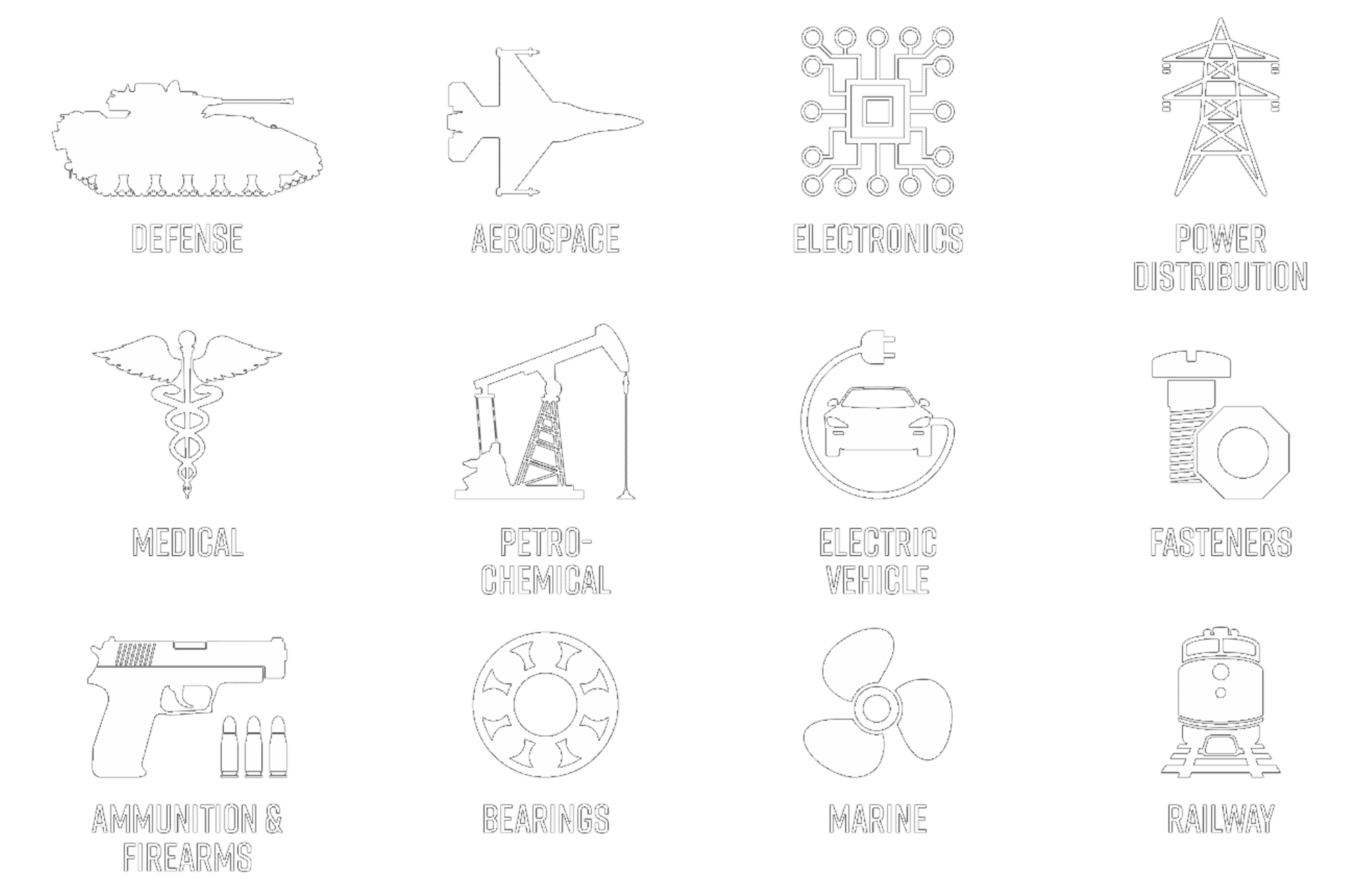
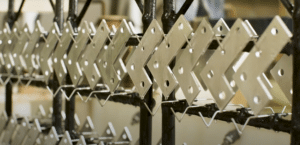
What are Copper Busbars used for?
Copper bus bars are used to distribute high amounts of current and used for mounting components and dissipating heat in various electrical and electronic applications. The main purpose of a busbar is to carry electricity and distribute it. Typically, C110 copper – a general purpose copper per ASTM B152 – is used in bus bar applications due to it having a very high conductivity and offering excellent formability. These properties make this copper grade a cost-effective choice for electronics, power equipment and automotive applications.
Why are Copper Busbars tin plated?
Copper Busbars are plated with bright or matte tin to further enhance the corrosion protection, electrical conductivity and solderability of the copper bus bar. Tin has many favorable properties including excellent conductivity, solderability, corrosion protection and it provides an optimal surface for electrical and heat transfer. Unlike raw copper bus, the tin coating provides a soft and ductile barrier which does not easily oxidize when exposed to oxygen or other elements. A raw copper bus will oxidize and lose conductivity very rapidly as compared to a tin coating. Although tin will eventually lose some conductivity tin forms a relatively thin oxide is still reasonably conductive.
What Industries use Tin Plated Copper Busbar?
Tin-plated copper busbars are used in a variety of industries and applications, including:
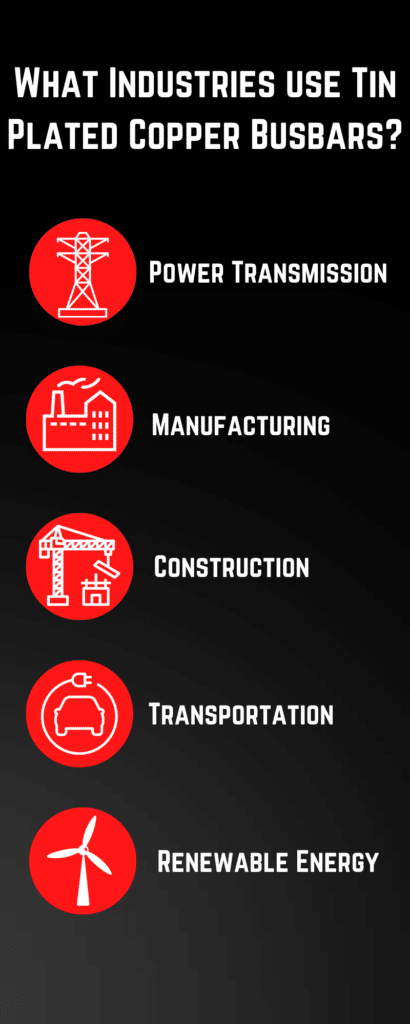
Manufacturing: Tin-plated copper busbars are used in manufacturing environments to provide power to machinery, tools, and other equipment. The tin plating greatly improves the soldering process to ensure a reliable joint with low voltage drop.
Construction: Tin-plated copper busbars are used in the construction industry to provide power to buildings and other structures within power panels. Tin plating helps to extend the life of the busbars and breaker components as well as improve their appearance.
Transportation: Tin-plated copper busbars are used in the transportation industry to power electric vehicles, such as electric buses, trains, and trams. The tin plating can help to improve the electrical conductivity and reliability of the busbars.
Renewable energy: Tin-plated copper busbars are used in renewable energy systems, such as solar panels and wind turbines, to transmit electrical current from the generation source to the point of use or point of storage (battery banks). The tin plating can help to improve the electrical conductivity and corrosion resistance of the busbars especially in humid environments.
Overall, tin-plated copper busbars are used in a variety of industries and applications due to a range of properties that are favorable to reliable transfer of electrical current and heat transfer over the lifespan of the product.
What type of Tin Should I use on my Copper Busbar?
Busbars can be used in a wide variety of applications. When specifying a tin coating for a busbar application, there are a few key characteristics to consider. 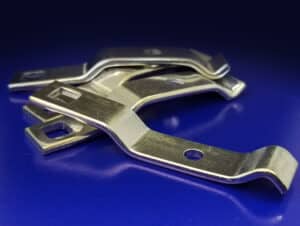
Electrolytic Bright Tin: Bright tin should be specified for copper bus bars or contacts that require improved electrical conductivity, corrosion protection and lubricity. Bright tin is a lustrous deposit that offers improved cosmetic appeal as well as these improved functional characteristics. However, bright tin should not be used in soldering applications as the brightener systems used to create the bright deposit will co-deposited organic elements into the tin deposit. These organic brighteners can cause de-wetting or even charring or blackening of the solder joint which can impede the durability of the solder joint especially when using mild fluxes.
Electrolytic Matte Tin (Solderable Tin): Matte or solderable tin should be specified for copper bus bars or contacts that require soldering, improved electrical conductivity, and corrosion protection with an industrial non-reflective finish. Due to the coarse grain structure, matte tin can result in higher initial insertion forces of mating contacts. A un-brightened nickel underplate is recommended prior to the matte tin to minimize diffusion of base material elements such as copper or zinc (for brass components) into the tin deposit. The nickel underplate provides an excellent base to solder to and ensures the longest possible shelf life of a solderable, matte tin deposit.
Matte tin is less aesthetically pleasing compared to bright tin but will provide a functional finish for soldering since it is free of any intentionally added organic compounds. The dull finish of matte tin can be burnished by part-to-part contact and as such care should be taken in packaging of larger parts to minimize contact if a uniform, dull finish is desired. Larger of heavier barrel plated parts will naturally have burnishing marks on the surface.
Hot-dip tin: Hot-dip tin is applied by immersing the part in a bath of molten tin. This process produces a heavy deposit of tin often 0.001” or more. It also can be used to coat complex or irregularly shaped parts since the tin deposits wherever the part is wetted during immersion in the molten bath. Hot-dip tin will result in buildup or pooling in corners, threads and ID features of parts and as such, should not be used on parts with tight tolerances.
Tin/Lead: Tin/lead plating is an alloy of tin and lead that can range from 5/95 (5% tin to 95% lead) to 95/5 (95% tin to 95% lead) tin/lead. The specific alloy will affect coating properties such as corrosion & chemical resistance, melting point and solderability. Tin/lead plating of copper bus bars or contacts is often used when tin/lead solder is specified. The addition of a small percentage of lead within the tin prevents the formation of tin whiskers which is desirable for critical electronic applications where whiskers can cause a short circuit path. The addition of lead greatly improves the chemical resistance of the deposit to mineral acids such as sulfuric acid making tin/lead plating of copper bus bars popular for lead/acid battery applications.
Ultimately, the best type of tin to use on a copper bus bar will depend on the specific requirements of the application, including factors such as corrosion & chemical resistance, electrical conductivity, soldering characteristics and cosmetics. It is important to carefully consider these factors and consult with a plating specialist to determine the best type of tin for a particular application.
Benefits of Tin plated Copper Busbars
Tin plating is a versatile and functional plating for copper busbars and electronic applications due to its low cost, corrosion protection, conductivity, solderability, heat-transfer and anti-galling characteristics. A brief summary of these benefits is provided below:
- Highly Solderable: A matte tin coating is recommended for solderable applications as it is free of brighteners that can impede soldering, especially when using mild fluxes. Matte tin readily
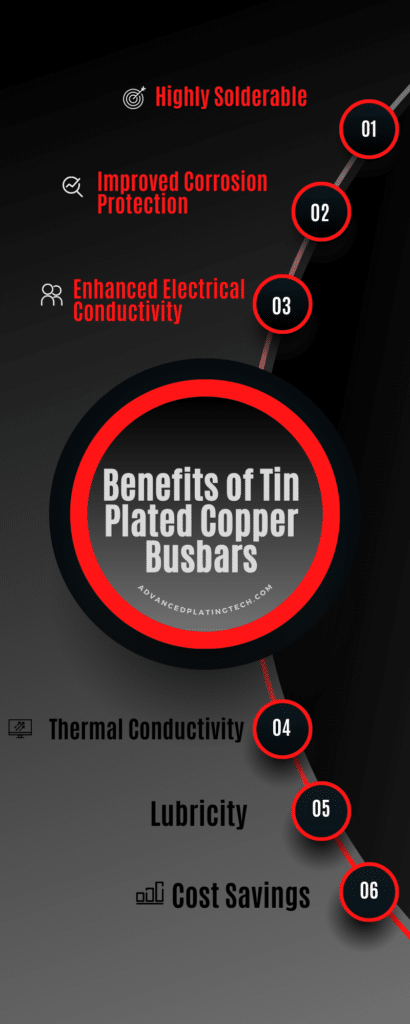
- Improved Corrosion Protection: Tin is a corrosion-resistant metal and tin plating on copper bus bars can help protect the underlying copper from corrosion, especially in environments with high humidity or other corrosives. Tin plating provides barrier corrosion protection and is therefore, directly proportional to the deposit thickness. Depending on the application for the busbar, a general guideline for good corrosion protection is around 0.0005 inches (12.5um) of tin and excellent corrosion protection occurs around 0.001 inches (25um).
- Enhanced Electrical Conductivity: Tin is a highly conductive metal, and its oxides are more conductive than that of copper or aluminum. In addition, tin oxides remain relatively thin and are easily wiped for sliding contacts such as male/female pins or stab finger-style contacts. In lapping contacts such as joined copper bus bars, there is minimal oxide formation within the contact joint.
- Thermal Conductivity: Tin plating provides good thermal conductivity of 0.67 W/cm*K to allow for the transfer of heat away from joints or contact surfaces. Since tin is a soft, malleable metal, it reduces the air-gap within lapped joints further improving the ability to transfer heat away from the joint.
- Lubricity: Tin is a naturally lubricating metal that resists galling in metal-on-metal wear applications. It is relatively soft and offers some embeddability of debris to reduce abrasive erosion within a contact or wear surface. Tin is commonly used as a dry-film lubricant on stainless steel fasteners to avoid galling in high load applications.
- Cost Savings: Since tin is readily available and non-precious, it is a considerable cost saver when compared to other precious coatings such as gold, silver, or palladium. In addition, tin electroplating is a very efficient process and can achieve over 0.0005” (12.5um) of thickness in under 1-hr of barrel plating and under 20-mins of rack plating at typical plating rates. This is less than half the time that an equivalent deposit of nickel would require. The affordability of tin metal combined with the fast plating rate, makes tin a more competitive option when compared to other non-precious, conductive metals such as nickel or electroless nickel.
Conclusion
With the on-going developments within the electronics, electric vehicle, and power distribution industries, the need for a cost-effective and conductive metal is growing in demand. Tin plating provides many desirable attributes for these industries including improved conductivity, lubricity, solderability, heat transfer and corrosion resistance. Tin plating of copper bus bars is commonly used to provide a cost-effective, conductive coating to ensure reliable current transfer over the life of the product. Tin plating is offered in both matte and bright formulations and can be alloyed with elements such as lead to improve solderability and chemical resistance. Tin plating can be preceded by an underplate of copper or nickel to optimize the function, solderability and longevity of the plated bus, contact or terminal.
Advanced Plating Technologies (APT) has a team of dedicated engineers and technical sales members who can assist with any application, specification or general questions for your tin plating needs. APT has 75 years of experience plating tin and tin alloys for various power industries and can help assist with most company specifications.
Blog Authored by Luke Copp, Sales & Marketing Associate
